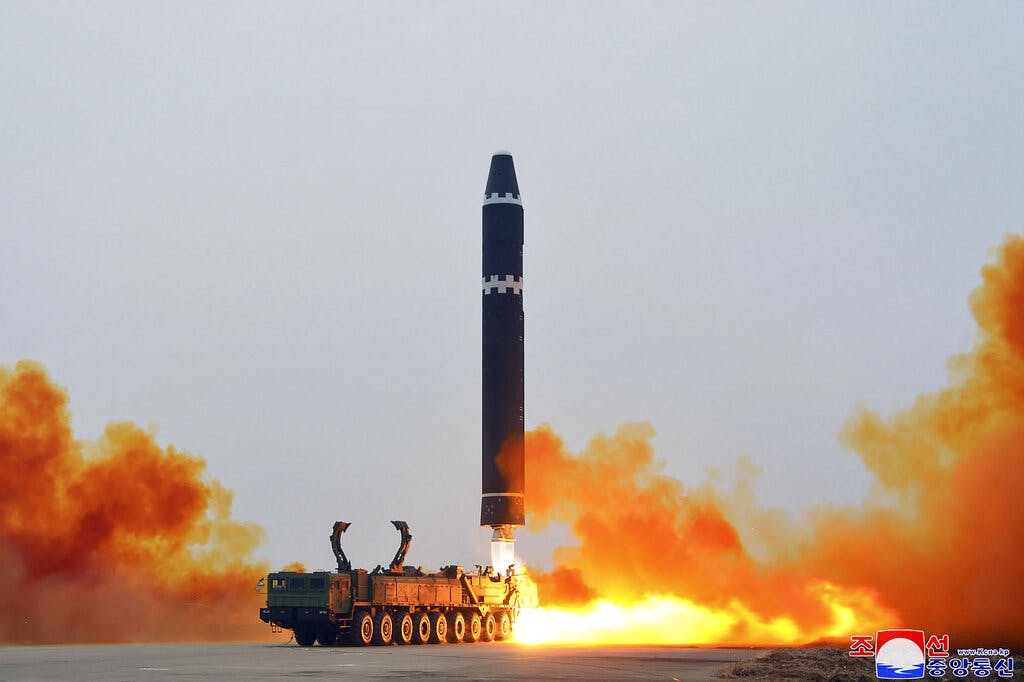U.S. Bombers Aloft as North Korea Tests New Long-Range Missiles
The North Korean report left no doubt the ultimate aim was to be able to attach a nuclear warhead to the missile.

They’re at it again. North Korea has test-fired a long-range ballistic missile that it warns has nuclear potential, and the Americans, South Koreans and Japanese have flown fighter planes in the latest joint war games.
It was the first time North Korea has test-fired a missile since January 1 — and the first inter-continental missile the North has fired since November, when leader Kim Jong-un witnessed the launch of the North’s latest model, a Hwasong-17, with his daughter, Ju-ae, believed to be 10 years old.
This time, said Pyongyang’s Korean Central News Agency, the North’s Red Flag Hero Company fired a Hwasong-15 in “a sudden launching drill,” meaning they showed they could launch it on extremely short notice under combat conditions. The missile, fired from Pyongyang International Airport, plunged into the sea near the northern Japanese island of Hokkaido.
The United States responded by flying long-range supersonic bombers B1 bombers along with F35s and F16s while South Korea flew F15K’s in a show of force later Sunday that may have been planned well in advance but seemed to have been in retaliation for the North Korean missile shot.
South Korea’s joint general staff said the drills showed “the alliance’s overwhelming forces” and the Americans’ capacity for “immediate deployment of the U.S. extended deterrence assets to the Korean Peninsula.”
American and Japanese war planes also flew together — an incredible show of force by America’s two northeast Asian allies, despite their mutual suspicion dating from the era of Japanese colonial rule. Significantly, the American and South Korean aerial display was separate from that of the American and Japanese planes.
“Deterrence” was also the operative word for the North Koreans — in their case in the form of nuclear weaponry.
KCNA said Sunday the missile test, ordered in writing by Mr. Kim, reconfirmed and verified “the reliability of the weapon system” while “proving confidence and guaranteeing the correct operation, reactivity, reliability, effectiveness and combat capability of the components of the state nuclear deterrence.”
The Japanese broadcaster NHK showed a video of the missile shining like a meteor or shooting star while falling about 125 miles off-shore — well within Japan’s Exclusive Economic Zone. NHK “captured footage of what appeared to be a fireball falling from the sky,” the Japan Times reported. Japan’s defense ministry “estimated the missile to have splashed down” in the same area as the missile fired in November.
The missile soared almost straight up into the atmosphere, achieving an apogee of 5,700 kilometers, or 3,542 miles. Japan’s defense ministry said the missile was capable of going 14,000 kilometers, 8,700 miles — far enough, said the defense minister, Yasukazu Hamada, to “put the entire United States within its range.”
The KCNA report left no doubt the ultimate aim was to be able to attach a nuclear warhead to the missile.
“The surprise ICBM launching drill,” said KCNA in English, ” provided “actual proof” of North Korea’s “strategic nuclear force’s consistent efforts to turn its capacity of fatal nuclear counterattack on the hostile forces” and insure the “reliability of our powerful physical nuclear deterrent.”
North Korea is not believed likely to fire a missile with a nuclear warhead, but the latest missile shot signaled the North’s determination to respond forcefully to war games among American, South Korean and possibly Japanese forces..
The pace of military cooperation between Washington and Seoul has intensified since the victory nearly one year ago, by a narrow margin, of South Korea’s conservative president, Yoon Suk-yeol, over a liberal opponent. Mr. Yoon replaced the liberal Moon Jae-in, who had failed in efforts at North-South reconciliation. Mr. Moon was barred by South Korea’s constitution from seeking a second five-year term.
The missile clearly tightened the bond between South Korea and its American ally as they prepare for military exercises. “While strengthening its monitoring and vigilance, our military,” said a statement by the South’s Joint Chiefs of Staff, “our military is maintaining a full readiness posture in close cooperation with the United States.”
The test was also sure to encourage South Korea to engage in war games involving the Japanese as well as the Americans despite ongoing differences reflecting Japan’s harsh rule over Korea from 1910 until the Japanese surrender in 1945. South Korea is still demanding, among other things, compensation for the descendants of Koreans forced to work in Japanese factories during World War II.
Japan’s Prime Minister Fumio Kishida responded with predictable “outrage” to the test, which he said jeopardized the “whole international community.” The missile added to Mr. Kishida’s calls for vastly increasing Japan’s defense budget while developing its own missiles — and missile defense systems.

